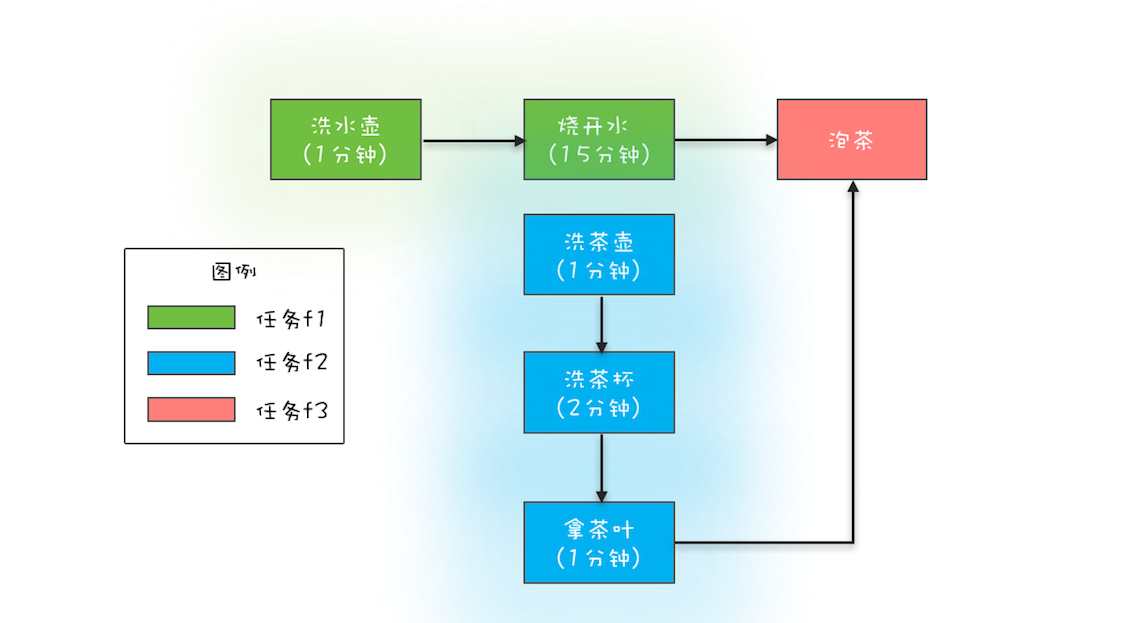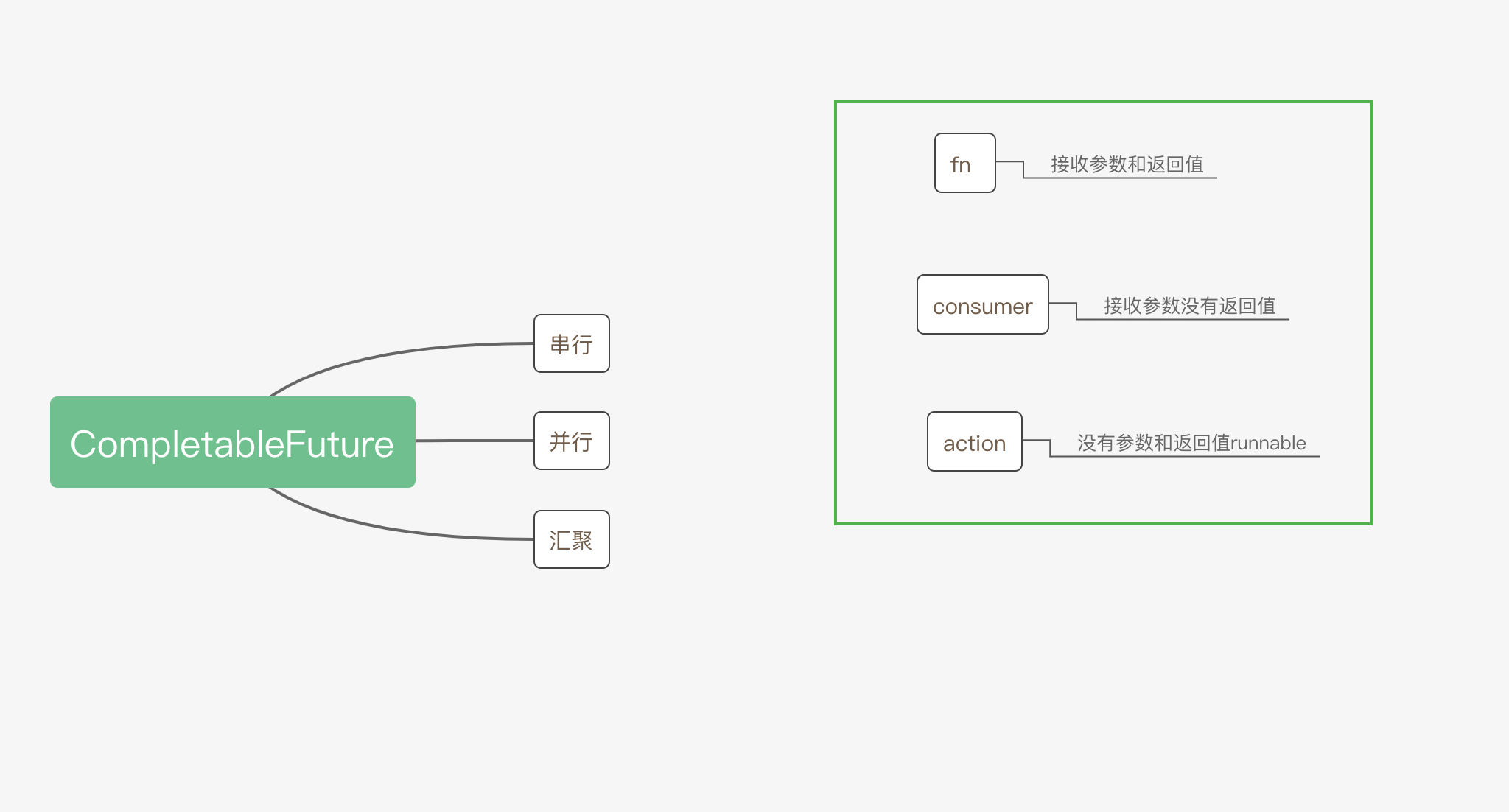CompletableFuture 的核心优势
为了领略 CompletableFuture 异步编程的优势,这里我们用 CompletableFuture 重新实现前面曾提及的烧水泡茶程序。首先还是需要先完成分工方案,在下面的程序中,我们分了 3 个任务:任务 1 负责洗水壶、烧开水,任务 2 负责洗茶壶、洗茶杯和拿茶叶,任务 3 负责泡茶。其中任务 3 要等待任务 1 和任务 2 都完成后才能开始。这个分工如下图所示。
下面是代码实现,你先略过 runAsync()、supplyAsync()、thenCombine() 这些不太熟悉的方法,从大局上看,你会发现:
- 无需手工维护线程,没有繁琐的手工维护线程的工作,给任务分配线程的工作也不需要我们关注;
- 语义更清晰,例如
f3 = f1.thenCombine(f2, ()->{})能够清晰地表述“任务 3 要等待任务 1 和任务 2 都完成后才能开始”; - 代码更简练并且专注于业务逻辑,几乎所有代码都是业务逻辑相关的。
// 任务 1:洗水壶 -> 烧开水CompletableFuture<Void> f1 = CompletableFuture.runAsync(()->{System.out.println("T1: 洗水壶...");sleep(1, TimeUnit.SECONDS);System.out.println("T1: 烧开水...");sleep(15, TimeUnit.SECONDS);});// 任务 2:洗茶壶 -> 洗茶杯 -> 拿茶叶CompletableFuture<String> f2 = CompletableFuture.supplyAsync(()->{System.out.println("T2: 洗茶壶...");sleep(1, TimeUnit.SECONDS);System.out.println("T2: 洗茶杯...");sleep(2, TimeUnit.SECONDS);System.out.println("T2: 拿茶叶...");sleep(1, TimeUnit.SECONDS);return " 龙井 ";});// 任务 3:任务 1 和任务 2 完成后执行:泡茶CompletableFuture<String> f3 = f1.thenCombine(f2, (__, tf)->{System.out.println("T1: 拿到茶叶:" + tf);System.out.println("T1: 泡茶...");return " 上茶:" + tf;});// 等待任务 3 执行结果System.out.println(f3.join());void sleep(int t, TimeUnit u) {try {u.sleep(t);}catch(InterruptedException e){}}// 一次执行结果:T1: 洗水壶...T2: 洗茶壶...T1: 烧开水...T2: 洗茶杯...T2: 拿茶叶...T1: 拿到茶叶: 龙井T1: 泡茶...上茶: 龙井
创建 CompletableFuture 对象
// 使用默认线程池static CompletableFuture<Void> runAsync(Runnable runnable)static <U> CompletableFuture<U> supplyAsync(Supplier<U> supplier)// 可以指定线程池static CompletableFuture<Void> runAsync(Runnable runnable, Executor executor)static <U> CompletableFuture<U> supplyAsync(Supplier<U> supplier, Executor executor)
- 它们之间的区别是:Runnable 接口的 run() 方法没有返回值,而 Supplier 接口的 get() 方法是有返回值的。
- 默认情况下 CompletableFuture 会使用公共的 ForkJoinPool 线程池,这个线程池默认创建的线程数是 CPU 的核数,强烈建议你要根据不同的业务类型创建不同的线程池,以避免互相干扰。
创建完 CompletableFuture 对象之后,会自动地异步执行 runnable.run() 方法或者 supplier.get() 方法,对于一个异步操作,你需要关注两个问题:一个是异步操作什么时候结束,另一个是如何获取异步操作的执行结果。因为 CompletableFuture 类实现了 Future 接口,所以这两个问题你都可以通过 Future 接口来解决。另外,CompletableFuture 类还实现了 CompletionStage 接口,这个接口内容实在是太丰富了,在 1.8 版本里有 40 个方法,这些方法我们该如何理解呢?
如何理解 CompletionStage 接口
我觉得,你可以站在分工的角度类比一下工作流。任务是有时序关系的,比如有串行关系、并行关系、汇聚关系等。这样说可能有点抽象,这里还举前面烧水泡茶的例子,其中洗水壶和烧开水就是串行关系,洗水壶、烧开水和洗茶壶、洗茶杯这两组任务之间就是并行关系,而烧开水、拿茶叶和泡茶就是汇聚关系。

1. 描述串行关系
CompletionStage<R> thenApply(fn);CompletionStage<R> thenApplyAsync(fn);CompletionStage<Void> thenAccept(consumer);CompletionStage<Void> thenAcceptAsync(consumer);CompletionStage<Void> thenRun(action);CompletionStage<Void> thenRunAsync(action);CompletionStage<R> thenCompose(fn);CompletionStage<R> thenComposeAsync(fn);
2. 描述并行关系
CompletionStage<R> thenCombine(other, fn);CompletionStage<R> thenCombineAsync(other, fn);CompletionStage<Void> thenAcceptBoth(other, consumer);CompletionStage<Void> thenAcceptBothAsync(other, consumer);CompletionStage<Void> runAfterBoth(other, action);CompletionStage<Void> runAfterBothAsync(other, action);
3. 描述or关系
CompletionStage applyToEither(other, fn);CompletionStage applyToEitherAsync(other, fn);CompletionStage acceptEither(other, consumer);CompletionStage acceptEitherAsync(other, consumer);CompletionStage runAfterEither(other, action);CompletionStage runAfterEitherAsync(other, action);

4. 异常处理
虽然上面我们提到的 fn、consumer、action 它们的核心方法都不允许抛出可检查异常,但是却无法限制它们抛出运行时异常,例如下面的代码,执行 7/0 就会出现除零错误这个运行时异常。非异步编程里面,我们可以使用 try{}catch{}来捕获并处理异常,那在异步编程里面,异常该如何处理呢?
CompletableFuture<Integer>f0 = CompletableFuture..supplyAsync(()->(7/0)).thenApply(r->r*10);System.out.println(f0.join());
CompletionStage 接口给我们提供的方案非常简单,比 try{}catch{}还要简单,下面是相关的方法,使用这些方法进行异常处理和串行操作是一样的,都支持链式编程方式。
CompletionStage exceptionally(fn);CompletionStage<R> whenComplete(consumer);CompletionStage<R> whenCompleteAsync(consumer);CompletionStage<R> handle(fn);CompletionStage<R> handleAsync(fn);
下面的示例代码展示了如何使用 exceptionally() 方法来处理异常,exceptionally() 的使用非常类似于 try{}catch{}中的 catch{},但是由于支持链式编程方式,所以相对更简单。既然有 try{}catch{},那就一定还有 try{}finally{},whenComplete() 和 handle() 系列方法就类似于 try{}finally{}中的 finally{},无论是否发生异常都会执行 whenComplete() 中的回调函数 consumer 和 handle() 中的回调函数 fn。whenComplete() 和 handle() 的区别在于 whenComplete() 不支持返回结果,而 handle() 是支持返回结果的。
CompletableFuture<Integer>f0 = CompletableFuture.supplyAsync(()->7/0)).thenApply(r->r*10).exceptionally(e->0);System.out.println(f0.join());

